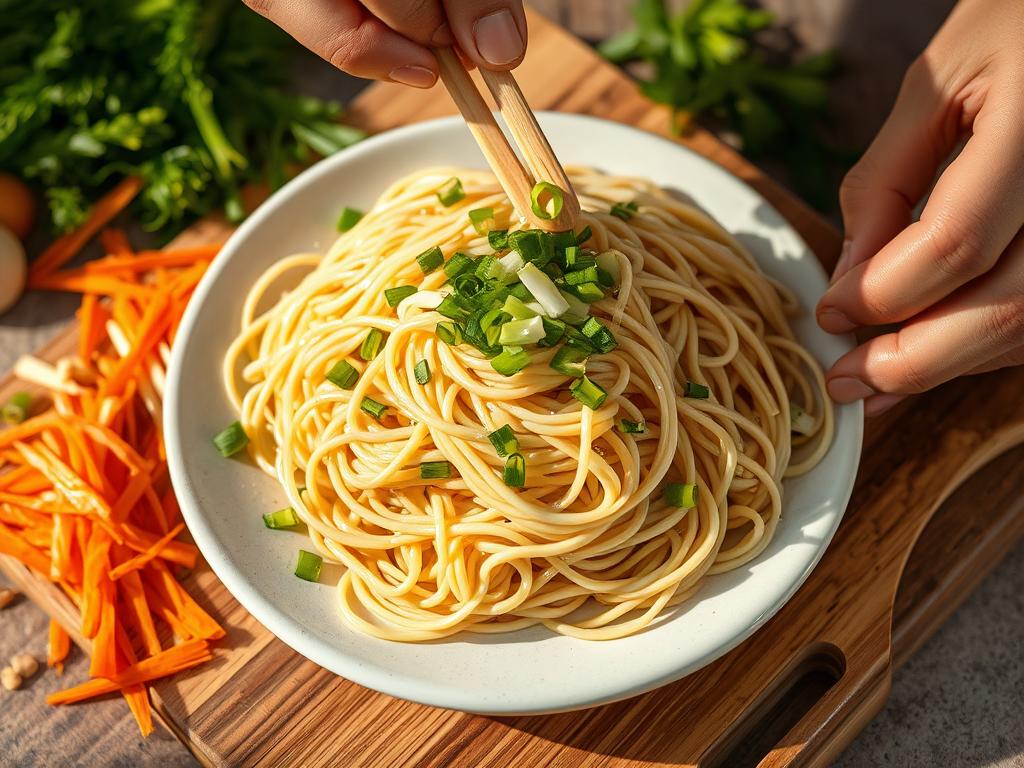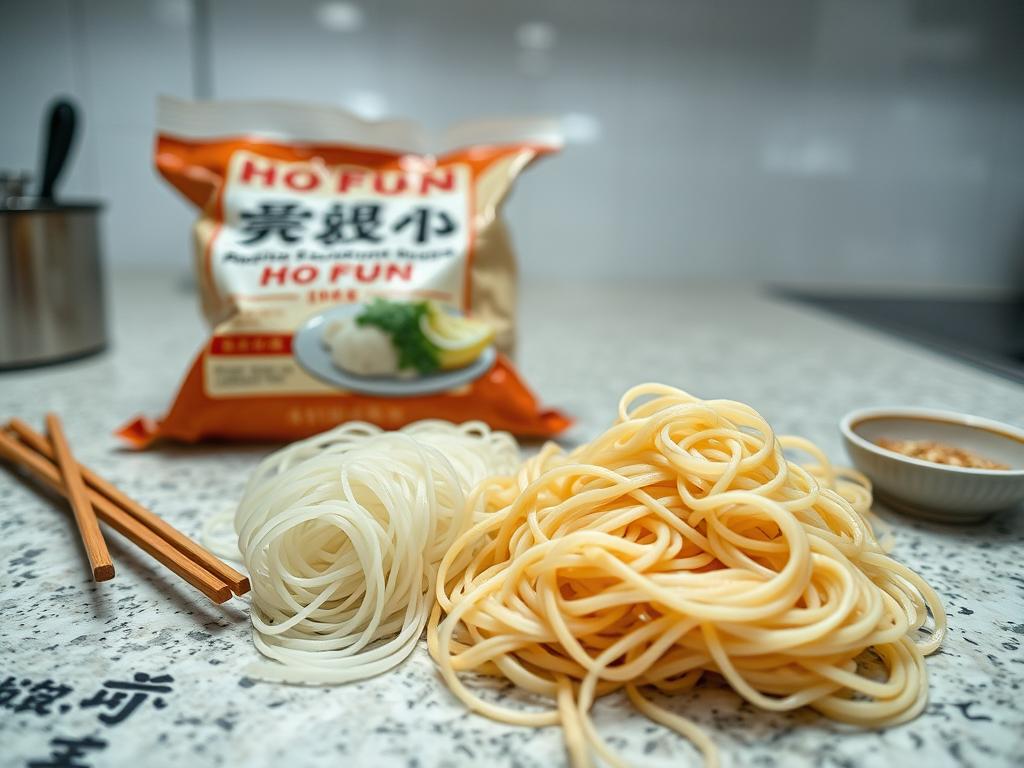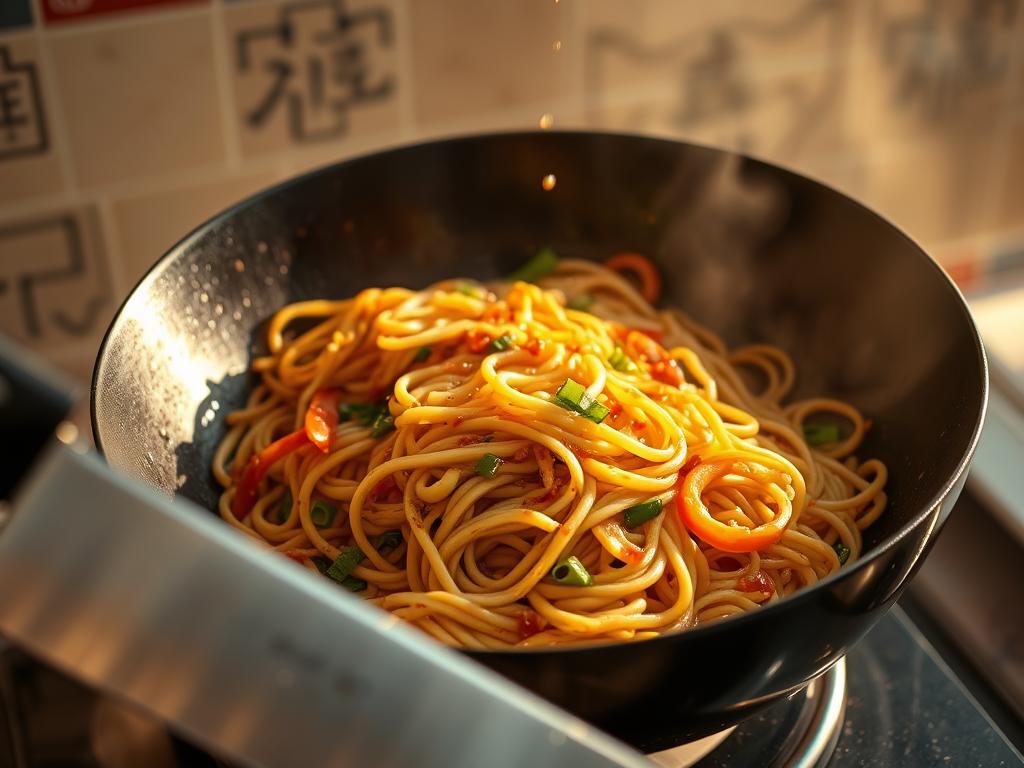Ho Fun Noodles: A Savory Asian Delight
Imagine a dish so versatile, it can be tailored to your every craving. Ho fun noodles, also known as chow fun, are a beloved staple in Asian cuisine, originating from the culinary heartlands of Hong Kong and southern China. These wide, silky rice noodles have won the hearts of many with their unique texture and flavor.
What makes ho fun noodles truly special is their adaptability. Whether you’re a vegetarian, vegan, or a meat lover, this dish can be customized to suit your taste. Stir-fried to perfection in just about 20 minutes, it’s a quick yet satisfying meal that’s hard to resist. Fresh or dried, the noodles absorb the vibrant flavors of your chosen sauce, creating a harmonious balance of tastes in every bite.
For home cooks, ho fun noodles offer endless possibilities. From the savory richness of beef to the light freshness of vegetables, each ingredient enhances the dish without overwhelming it. It’s not just about the taste—it’s about the experience. So, take a moment to explore the world of ho fun and discover how this simple dish can become a masterpiece on your plate.
Table of Contents
Discovering the Roots and Varieties of Ho Fun Noodles
Ho fun noodles, also known as chow fun, have a rich history rooted in the culinary traditions of southern China and Hong Kong. This beloved dish has traveled across Southeast Asia, becoming a staple in countries like Singapore and Malaysia. Its widespread popularity is a testament to its adaptability and delicious flavor profile.
Origins and Cultural Significance
Originating from the Cantonese cuisine of southern China, ho fun noodles have been a comfort food for generations. The dish gained prominence in Hong Kong, where it became a favorite in both street food stalls and home kitchens. Over time, it spread to other regions, adapting to local tastes while retaining its core identity.
In many Asian cultures, ho fun noodles are more than just a meal; they represent a connection to heritage. In Singapore and Malaysia, for instance, the dish is often served in hawker centers, where it’s celebrated for its bold flavors and hearty portions. This cultural significance highlights the dish’s enduring appeal and its role in bringing people together.
Exploring Different Types of Rice Noodles
Rice noodles come in various forms, each offering unique textures and tastes. Fresh flat noodles are prized for their silky smoothness, while dried flat noodles provide a slightly firmer bite. Wide rice noodles, often used in stir-fries, are another popular variety, cherished for their chewy consistency.
The choice between fresh and dried noodles can greatly impact the dish. Fresh noodles are ideal for stir-fries, as they absorb sauces beautifully without becoming mushy. Dried noodles, on the other hand, are more versatile and can be used in a variety of cooking methods, from soups to salads.
Some homemade versions incorporate tapioca starch to achieve a chewier texture, adding a delightful twist to the traditional recipe. Whether you prefer the softness of fresh noodles or the heartiness of dried ones, there’s a type of rice noodle to suit every taste.
Key ingredients like green onions, garlic, and shiitake mushrooms define the authentic flavor profile of ho fun noodles. These elements, combined with the noodles’ natural starchiness, create a dish that’s both satisfying and flavorful. By appreciating the heritage behind every strand, you can deepen your enjoyment of this culinary treasure.
How to Cook Ho Fun Noodles at Home
Cooking ho fun noodles is an art that combines quick preparation with flavorful results. With the right tools and ingredients, you can create a dish that rivals restaurant-quality meals. Let’s break down the process into manageable steps to ensure your cooking experience is both enjoyable and successful.
Preparing Your Ingredients and Tools
Start by gathering your ingredients. You’ll need rice noodles, your choice of protein (like beef or tofu), and vegetables such as mushrooms and bok choy. Essential tools include a wok or large skillet, a saucepan for boiling, and a cutting board for prep work.
Step-by-Step Cooking Process and Timing
Soak the noodles in warm water for about 10 minutes until they soften but still retain some firmness. While the noodles soak, heat a couple of tablespoons of oil in your wok. Sauté minced garlic and green onions until fragrant, then add your vegetables and protein, stirring quickly to ensure even cooking.
Once the vegetables are tender, add the pre-mixed sauce (soy sauce, oyster sauce, and sesame oil). Stir everything together for about 2-3 minutes. Finally, add the noodles, tossing them gently with the mixture. Cook for another 2-3 minutes, ensuring the noodles absorb the flavors without becoming mushy.

Remember, timing is crucial. The entire process should take about 20 minutes, allowing you to serve a fresh, hot meal. For leftovers, reheat gently with a splash of water to maintain texture.
Tips for Customizing Your Ho Fun Noodles Recipe
Transform your ho fun noodles into a personalized masterpiece by experimenting with flavors and ingredients. Whether you’re a fan of hearty proteins or vibrant veggies, this dish adapts effortlessly to your preferences.
Add Your Favorite Veggies and Proteins
Enhance your ho fun noodles by adding your favorite vegetables like bok choy, mushrooms, or bean sprouts. For protein lovers, sliced beef or cubed tofu makes a delicious addition. These ingredients not only add texture but also bring fresh flavors to the dish.
Perfecting the Sauce, Oil, and Seasoning
The sauce is the heart of your ho fun noodles. Mix soy sauce, oyster sauce, and a drizzle of sesame oil for a rich, umami flavor. Adjust the quantities to your taste, adding more soy sauce for saltiness or sesame oil for aroma. This balance creates a sauce that’s both savory and fragrant.
| Ingredient | Effect |
|---|---|
| Bok Choy | Adds crunch and freshness |
| Mushrooms | Introduces earthy flavors |
| Beef | Provides hearty texture |
| Soy Sauce | Enhances saltiness |
| Sesame Oil | Boosts aroma |

Customizing your ho fun noodles allows you to create a dish that’s uniquely yours, whether you’re vegan, vegetarian, or a meat enthusiast. Each adjustment honors the dish’s roots while catering to your taste, making every bite a delightful experience.
Techniques for Handling Store-Bought vs. Homemade Noodles
When it comes to preparing ho fun noodles, understanding how to handle store-bought and homemade varieties is essential for achieving the best results. Proper techniques ensure your dish turns out flavorful and textured just right.
Soaking and Rehydrating Dried Rice Noodles
For store-bought dried rice noodles, soaking is key. Submerge them in boiling water for 3-5 minutes until they soften but still have some firmness. After soaking, rinse them under cold water to stop cooking and drain well. Lightly oil the noodles to prevent clumping during stir-frying.
Fresh homemade noodles, on the other hand, are softer and more delicate. They require a quick rinse before cooking and no soaking. Their texture is more prone to tearing, so gentle handling is necessary to maintain their integrity.
| Handling Aspect | Store-Bought Dried | Homemade Fresh |
|---|---|---|
| Texture | Firmer, chewier | Soft, delicate |
| Cooking Time | Shorter, after soaking | Quick, no soaking needed |
| Tips | Soak, rinse, oil | Rinse gently, handle with care |
Achieving the right texture is crucial for a restaurant-quality experience. Overcooking can make noodles mushy, so monitor them closely. Whether using store-bought or homemade, adjust cooking times slightly to ensure perfection. Experiment with both methods to find your preference and master the art of ho fun noodles.

Conclusion
With its rich cultural roots and versatility, ho fun noodles offer a culinary experience that’s both satisfying and easy to customize. Originating from southern China and Hong Kong, this dish has evolved into a beloved staple across Asia, adapting to local tastes while retaining its core identity. Whether you prefer beef, tofu, or a vibrant mix of vegetables, ho fun noodles can be tailored to suit every palate and dietary preference.
The key to a perfect ho fun dish lies in its preparation. Soaking dried noodles briefly before stir-frying ensures they retain their chewy texture, while fresh noodles require a gentle rinse. Pairing these with a balanced sauce—made from soy sauce, oyster sauce, and a hint of sesame oil—creates a harmonious blend of flavors. Don’t forget to add your favorite protein or vegetables for added texture and taste.
Ready to give it a try? With just 20 minutes of cooking time, you can create a restaurant-quality meal at home. Remember to handle the noodles with care to avoid overcooking, and don’t hesitate to experiment with different ingredients. Share your creations on social media and let us know how your ho fun noodle journey unfolds!
Looking for more inspiration? Explore our blog for additional recipes and tips on crafting authentic Asian dishes that will delight your family and friends. Happy cooking!
FAQ
What are Ho Fun Noodles made of?
Ho Fun Noodles are typically made from rice flour and water, giving them a chewy texture. They are a popular choice in Asian cuisine for their versatility in dishes like stir-fries and chow fun.
How do I cook Ho Fun Noodles quickly?
To cook Ho Fun Noodles quickly, soak them in hot water for about 5-7 minutes until soft. Drain and rinse with cold water to stop cooking, then add to your dish.
Can Ho Fun Noodles be used in dishes other than stir-fries?
Yes, they can be used in soups, salads, or as a base for bowls. Their mild flavor makes them a great addition to various recipes.
How do I prevent Ho Fun Noodles from sticking together?
After cooking, toss them with a small amount of oil or sauce to keep them separate and prevent sticking.
Can I make Ho Fun Noodles at home?
Yes, you can make Ho Fun Noodles at home using rice flour and water. The process involves mixing the dough, rolling it out, and cutting it into strips before cooking.
What is the difference between Ho Fun and other rice noodles?
Ho Fun Noodles are wider and thicker compared to other rice noodles, giving them a heartier texture that holds up well in stir-fries and chow fun dishes.
What sauces are best for Ho Fun Noodles?
Soy sauce, oyster sauce, and hoisin sauce are popular choices. You can also use a combination of these for added flavor.
Can I prepare Ho Fun Noodles ahead of time?
Yes, cook and season them, then store in an airtight container in the fridge for up to a day. Reheat gently when ready to use.
Are there gluten-free Ho Fun Noodles available?
Yes, many brands offer gluten-free versions made purely from rice, making them suitable for those with dietary restrictions.
How should I store leftover Ho Fun Noodles?
Store leftovers in an airtight container in the refrigerator for up to three days. Reheat them in a pan with a bit of oil or sauce to restore texture.
LEAVE A REPLY
Your email address will not be published
Explore More:
- Delicious Beef Heart Recipes to Try Today
- Savory Cabbage and Hamburger Meat Meal
- Delicious Oven-Baked Chicken Cutlets: Quick & Tasty
- Enjoy a Satisfying Buffalo Chicken Salad
- Discover the Perfect Chicken Steak and Cheese Combo

